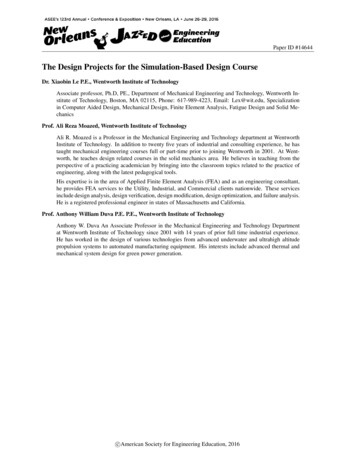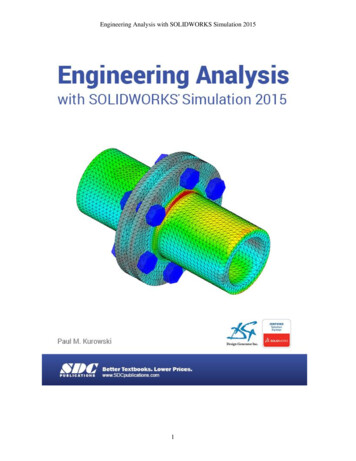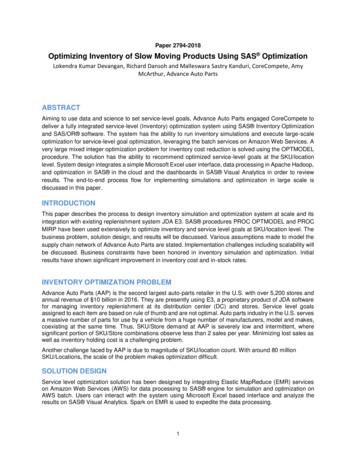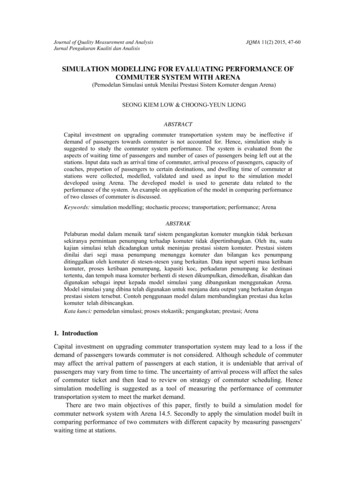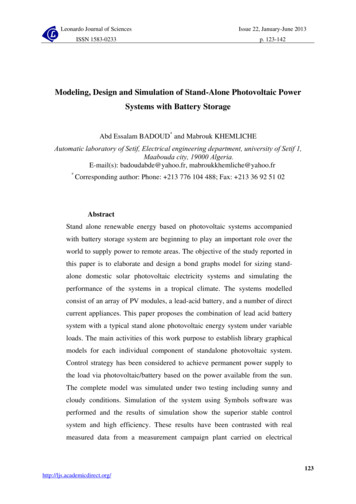
Transcription
Leonardo Journal of SciencesIssue 22, January-June 2013ISSN 1583-0233p. 123-142Modeling, Design and Simulation of Stand-Alone Photovoltaic PowerSystems with Battery StorageAbd Essalam BADOUD* and Mabrouk KHEMLICHEAutomatic laboratory of Setif, Electrical engineering department, university of Setif 1,Maabouda city, 19000 Algeria.E-mail(s): badoudabde@yahoo.fr, mabroukkhemliche@yahoo.fr*Corresponding author: Phone: 213 776 104 488; Fax: 213 36 92 51 02AbstractStand alone renewable energy based on photovoltaic systems accompaniedwith battery storage system are beginning to play an important role over theworld to supply power to remote areas. The objective of the study reported inthis paper is to elaborate and design a bond graphs model for sizing standalone domestic solar photovoltaic electricity systems and simulating theperformance of the systems in a tropical climate. The systems modelledconsist of an array of PV modules, a lead-acid battery, and a number of directcurrent appliances. This paper proposes the combination of lead acid batterysystem with a typical stand alone photovoltaic energy system under variableloads. The main activities of this work purpose to establish library graphicalmodels for each individual component of standalone photovoltaic system.Control strategy has been considered to achieve permanent power supply tothe load via photovoltaic/battery based on the power available from the sun.The complete model was simulated under two testing including sunny andcloudy conditions. Simulation of the system using Symbols software wasperformed and the results of simulation show the superior stable controlsystem and high efficiency. These results have been contrasted with realmeasured data from a measurement campaign plant carried on electrical123http://ljs.academicdirect.org/
Modeling, Design and Simulation of Stand-Alone Photovoltaic Power Systems with Battery StorageAbd Essalam BADOUD and Mabrouk KHEMLICHEengineering laboratory of Grenoble using various interconnection schemes arepresented.KeywordsStandalone System; Photovoltaic; Lead/acid battery; Modelling; Control;Bond Graph.IntroductionRenewable energy sources (solar, wind, etc) are attracting more attention as alternativeenergy sources than conventional fossil fuel energy sources. This is not only due to thediminishing fuel sources, but also due to environmental pollution and global warmingproblems. Among these sources is the solar energy, which is the most promising, as thefabrication of less costly photovoltaic (PV) devices becomes a reality. With increasedpenetration of solar PV devices, various antipollution apparatus can be operated such as waterpurification through electrochemical processing and stopping desert expansion by PV waterpumping with tree plantation. However, control problems arise due to large variances of PVoutput power under different insolation levels. Solar energy is attractive, because it directlyconverts solar radiation energy in to electricity. Its energy conversion and control system aresimple and easy to maintain. Being inherently sustainable and eco-friendly, the PV basedsystems are gaining popularity [1, 2]. Photovoltaic applications can be broadly classified intotwo categories. One is the standalone system and other is the grid connected system. Thestandalone system is widely used in remote places where access to electricity is not viable.The standalone configuration can provide a well regulated load voltage but the reliability ofpower supply cannot be guaranteed [3]. Storage batteries are widely used to improve theirliability of the standalone system [4]. The integration of PV system to the grid is rapidlyincreasing due to the improvement in the power electronics technology. Generally, singlephase or three phase voltage source inverters (VSI) are used for interfacing PV system to gridand employs a controller to stabilize the DC bus voltage and regulate the current injected intothe grid. Various topologies and control strategies for grid connected inverters have beenreported in literature. The grid connected PV systems (GCPV), feeding active power to thegrid can be controlled to supply there active power demand of the load [5].The continuous developments in the sector of photovoltaic applications have rendered124
Leonardo Journal of SciencesIssue 22, January-June 2013ISSN 1583-0233p. 123-142explicitly that the photovoltaic generators constitute a reliable technological and economicallyviable investment choice. The privileged climate of Algeria gives an enormous potential forthe installation of photovoltaic power plants connected to electricity grids or for individualuse.Algeria has successfully completed the plan for electrification for most of the villagesthrough the utility grid. Due to remoteness and cost, for some parts of Algeria it is unlikelythat the main grid connection will ever be established. A stand-alone PV system with storagebattery will be excellent choice for such areas. Sizing of the PV array, inverter and batterybank for a standalone PV system is an important part of system design. This part requiressolar radiation data for the intended geographical location of the site, load demand andmanufacturing data for PV modules, inverters and batteries and their operational efficiencies.In this paper, the PV model, battery model and the DC-AC inverter is implemented. Apopular tow diode model of PV is used in this work. An equivalent circuit model structure forlead-acid batteries is used to facilitate the battery model part of the system model. Buck-Boostconverter interface is used hence it is more suitable for battery charging. The purpose of thebuck-boost converter is used to control the power flow from the PV panel to battery and loadwhich requires MPPT control algorithm to find out the peak power of the PV panel. Bondgraph algorithm is used for MPP tracking. The complete system is simulated using Symbolssoftware.Proposed SystemFigure (1) show a stand-alone photovoltaic centralized system utilized to provideenergy for residences sited at remote locations, far from grid distribution lines.Figure 1. Proposed configuration125
Modeling, Design and Simulation of Stand-Alone Photovoltaic Power Systems with Battery StorageAbd Essalam BADOUD and Mabrouk KHEMLICHEThese systems are composed of a single array of photovoltaic panels, implemented in seriesand/or parallel connection depending on the power of the system. While using Buck-BoostDC/DC converters with bond graph MPPT for PV array to extract the maximum availablepower from them. The battery which is of Lead-Acid type is used to store the energy [6], toregulate the DC-Bus voltage through a reversible current DC/DC converter and to supply theload in the stand-alone case when low solar radiation conditions.The energy produced for PV source is transferred from the DC-Bus to the house loadthrough a DC/AC inverter controlled and filtered by an LC filter, while the excess powerfeeds the utility grid. Based on the data acquisition (Temperature, Irradiance, DC-Busvoltage etc) the Supervisory Controller send the commands to the different converters inorder to optimize and control the energy.Models of the PanelsThe modelling and simulation of photovoltaic system have made a great transition andform an important part of power generation in this present age. PV systems’ modellinghowever is quite complex. In literature, several computational methods are proposed byseveral researchers [7-10] for modelling the different components of stand-alone PV systems.Although some of these methods are impractical, complicated and require high computationaleffort, and some of these modelling was limited to simulation of photovoltaic modulecharacteristics. Other methods are based on software simulation using readymade programslike PSpice, Matlab-Simulink and Labview [11-12].Automatic data acquisition systems are currently used for both monitoring the systemperformance and control of its operation. The obtained information can be used to evaluatethe plant efficiency during long periods and to optimize future systems in terms ofperformance and reliability. These systems are based on the use of micro-controller andmicroprocessor for PV applications [13]. Artificial intelligence techniques are becominguseful as alternate approaches to conventional techniques or as components of integratedsystems. These methods used to model PV arrays, to estimate the maximum power pointtracker and to predict the produced energy from the system [14]. Recently, interest was givento the modelling and simulation of the whole PV system based on bond graph [15].126
Leonardo Journal of SciencesIssue 22, January-June 2013ISSN 1583-0233p. 123-142Bond graph is an explicit graphical tool for capturing the structures among thephysical systems and representing them as an energy network based on the exchange of power[16-17]. Others [18-20] have extended the bond graph concept to represent Phenomena suchas chemical kinetics and to extract causal models and control structures from the bond graphnetworks. Bond graph, a graphical modelling language, provides a model formalism thatdecomposes the system into subsystems that map to the physical connections [21]. Theresulting subsystems are essentially physical fields including mechanics, electronics,hydraulics, and chemistry. The time granularity for these domains is usually distinct.A Photovoltaic (PV) system directly converts sunlight into electricity. The basicdevice of a PV system is the photovoltaic cell; they may be grouped to form panels or arrays[5,22]. This model is the most classical one found in the literature and involves: a currentgenerator for modelling the incident luminous flux, two diodes for the cell polarizationphenomena, and two resistors (Rs and Rsh) for the losses.For the bond graph representation, the PV generator is then modeled by a flow sourceSf Iph in parallel with two resistors Rdiode and Rsh, the whole followed by a serial resistanceRs [8]. (Figure 2).Figure 2. Bond graph model of PV with tow diodesBuck-Boost DC/DC ConverterDC/DC converter performance optimization is important to accommodate the growingneed for efficiency in portable electronic device battery life and an ever increasing worldclimate of energy maximization. The equivalent circuit of the converter is illustrated in figure(3).127
Modeling, Design and Simulation of Stand-Alone Photovoltaic Power Systems with Battery StorageAbd Essalam BADOUD and Mabrouk KHEMLICHEFigure 3. Equivalent circuit of a buck-boost converterTo ensure the charge and the discharge of the storage battery, the current must bereversible so that the energy transfer would be in the two directions, from the DC-Bus to thebattery and vice versa. For that a Reversible current DC/DC converter is necessary, it'srealized by associating a boost chopper and a buck one as shown in figure (4).The bond graph model of converter DC/DC is thus given by the figure (5).Figure 4. Equivalent circuit of a the reversible current DC/DC converterFigure 5. Bond graph model of boost-up chopperGrid-Connected PV InverterGrid-Connected Inverter not only converts the direct current generated by photovoltaic128
Leonardo Journal of SciencesIssue 22, January-June 2013ISSN 1583-0233p. 123-142cells into alternating current but also connects with the control of the frequency, voltage,current, phase, active and reactive power, etc [9]. So the control of grid connected inverter hasalways been the focus of the study and the research methods are varied. The topology of Gridconnected inverters is shown below (Figure (6)).Figure 6. The structure of inverter (L 0.47 mH; c 20μF; r 0.9Ω)The transfer functions of inverter:Φ (s ) 1sc1sL r sc 11 9 2Lcs rcs 1 9.4 Χ 10 s 1.8 X 10-5s 12(1)After transformation:p(z) 0.126 z 0.122z 1.6606 z 0.90872(2)The bond graph model of the inverter with filter is given by figure (7).Figure 7. Bond Graph model of inverter with filter129
Modeling, Design and Simulation of Stand-Alone Photovoltaic Power Systems with Battery StorageAbd Essalam BADOUD and Mabrouk KHEMLICHEMPPT in Stand-Alone PV SystemsIn the literatures, many MPPT techniques have been proposed to achieve the goal forsolar and wind energy conversion systems, including the voltage feedback method (VFM),power feedback method (PFM), perturb and observe method (POM), and incrementalconductance method (ICM) [10-13]. They are based on load line adjustment under varyingatmospheric and load conditions. However, these uncertainties make MPPT less suitable forrapidly changing environmental conditions or parameter variations. Artificial intelligence (AI)methods, such as the neural network and Fuzzy based controller [14-16], have also providedan adaptive mechanism to improve efficiency, and have a robust capability in regard touncertainties.Figure 8. General Scheme for the proposed methodAs shown in figure (8) the stand-alone PV system includes a solar array, DC/DCconverter, resistive load and an MPPT control unit. The PV array converts solar energy toelectric energy. In its V-P characteristic curve, there is a maximum point commonly called themaximum power point (MPP), at which the module operates with the maximum efficiencyand produces the maximum power output Pmax. In order to obtain an operating point close tothis MPP, a controlled DC/DC converter is usually employed to interface the energy flowfrom the solar module to the load.The response time of the maximum PV power tracking due to a step irradiance inputreflects the tracking speed of the MPPT method.Energy StorageThere are many different storage technologies that can be utilized with photovoltaicsystems. Research is currently being undertaken into the use of ultracapacitors as a means of130
Leonardo Journal of SciencesIssue 22, January-June 2013ISSN 1583-0233p. 123-142energy storage for photovoltaic systems. Battery technology still remains the most popularchoice. Nickel cadmium and nickel metal hydride batteries can be used, but the lead acidbattery is still the most widely used storage method for stand-alone photovoltaic systems.In order to provide a complete charge for the battery an elaborated control strategymust be applied, such that the battery would be charged as fast as possible, within itsoperation limits, given that the daily generation period for the photovoltaic panels is limited.The batteries in a photovoltaic system operate in a cyclic way, discharging during the nightand recharging during the day. The most recommended charging process in this case is theone with constant voltage and current limitation [17]. The bond graph model of theaccumulator is shown in figure (9).Figure 9. Variation of power according to the tensionIts structure is in conformity with the physical structure of the accumulator: the halfreactions to the anode and cathode are explicit on the left and on the right respectively. Theelectrolyte, a sulphuric acid diluted mainly dissociated in H ions and HSO4-, takes part herein the principal reaction. Very theoretical electrochemical component can be seen like areversible transformer of chemical energy in electric power. We resorted to an element Cmultiport which makes it possible to represent a chemical energy transported duringdisplacements of the species (flow) with the associated efforts.The battery temperature enormously influences the behavior of the characteristic basicoperation of the storage system and in particular on its storage capacity.The following figure (10 and 11) shows that the increase in the temperature isaccompanied by an increase moderated with that of the batteries storage capacity. Attention,131
Modeling, Design and Simulation of Stand-Alone Photovoltaic Power Systems with Battery StorageAbd Essalam BADOUD and Mabrouk KHEMLICHEthis element C multiport does not store energy. This element "C multiport" also will enter thethermal energy exchanged with the environment.Figure 10. Influence temperature on the storage capacityTo study the influence of time, one seeks to approach with a close management in realtime, state of the battery load, which in its turn is determining for the effective exploitation ofthe storage system.Figure 11. Influence time on the state of the batteryIn the loading case, plus the duration of time increases, the batteries load state isbelow 1. In the case of the discharge, plus the time duration is significant. It is noted that the132
Leonardo Journal of SciencesIssue 22, January-June 2013ISSN 1583-0233p. 123-142state of discharge reaches its maximum value for a long duration discharge.Experimental ResultsA prototype MPPT system (figure 12) has been developed using the described methodand tested in the laboratory.Figure 12. Material and methods testThe PV array gives a 150W maximum power, a 43.5V open-circuit voltage and aclose-circuit current of 4.75A at a solar energy of 1 kW/m2 and a temperature of 25 C. ThePV array was simulated with two solar energy cases, 65.36mA/cm2 (case A) and 24.98mA/cm2 (case B) to test the proposed system under specific atmospheric conditions. Figure(13) and figure (14) plot the V-I and V-P curves under the two cases at 65 C.The PV array gives a 150 W maximum power, a 43.5 V open-circuit voltage and aclose-circuit current of 4.75 A at a solar energy of 1 kW/m2 and a temperature of 25 C.Figure (15) and figure (16) show the output voltage (CH1) and the current (CH2)wave forms. The solar energy is changed from A to B in Figure11. In Figure 15, the solarenergy is changed from B to A. In the case A, the MPP is 27.3 V, 7.75 A and 102.648 W. Andfor the case B, the MPP is 32.28 V, 2.64 A and 42.61 W.133
Modeling, Design and Simulation of Stand-Alone Photovoltaic Power Systems with Battery StorageAbd Essalam BADOUD and Mabrouk KHEMLICHEFigure 13. V-I curve under the case A and B at 65 CFigure 14. V-P curve under the case A and B at 65 CFigure 15. Output voltage and current of the PV array, the solar energy is changed from A toB (curve 1; 20 V/Div – 2.5 s/Div), (curve 2; 4 V/Div – 2.5 s/Div)134
Leonardo Journal of SciencesIssue 22, January-June 2013ISSN 1583-0233p. 123-142Figure 16. Output voltage and current of the PV array (the solar energy is changed from B toA) (curve 1; 20 V/Div – 2.5 s/Div), (curve 2; 4 V/Div – 2.5 s/Div)The operation of bond graph algorithm has been evaluated by the experiments. Figure(17) shows the important characteristics of the experimental bond graph MPPT control , theoutput power is always less than 800 W without MPPT bond graph control (see figure 20.A)and the output power is always greater than 850 W with MPPT bond graph control (see figure20.B).Figure 17. Output power (curve 1; 250 W/Div – 60 s/Div), (curve 2; 480 V/Div – 60 s/Div)The maximum of the power 850 W at 155 V, the global efficiency (3 %) (Figure 18.A). For a different value of irradiation (1000 W/m2, 800 W/m2, 600 W/m2 and 400 W/m2), the135
Modeling, Design and Simulation of Stand-Alone Photovoltaic Power Systems with Battery StorageAbd Essalam BADOUD and Mabrouk KHEMLICHEoptimal power rate is obtained for irradiance equal to 1000 W/m2 (850 W), corresponding to aglobal efficiency equal to 3 % (Figure 21. B).Figure 18. Variation of power according to the voltage (curve 1; 250 W/Div – 5 V/Div), PVpower of MPPT method under step changing irradiance (curve 2; 250 W/Div – 25 V/Div)As a result of the comparison between the experimental and the simulation and inorder to confirm the established bond graph MPPT control and the obtained simulations, webelonged to experimental measurements of the power according to the tension and the PVpower of MPPT method under step changing irradiance. The curves obtained are identical tosimulations. We can conclude that there is a similarity and concordance.Typical Annual Load Profile DefinitionThe typical annual load profile definition was also based on statistical analysis. In thisstatistical analysis a sample of 400 houses along with analytical data given by the Sonalgaz(Algerian society of electricity) were used and it was concluded that there are two peaks136
Leonardo Journal of SciencesIssue 22, January-June 2013ISSN 1583-0233p. 123-142observed on the consumption of electricity in the domestic sector annually; one in summer,which is the highest, and one in winter. On the other hand, autumn and spring periods havemore or less the same consumption of electricity which is lower compared to that of summerand winter. Also, another very important thing to notice is that the daily average electricityconsumption of a house is around 24 kWh during summer, 21 kWh during winter and 15 kWhduring autumn and spring.To be more precise on the definition of the typical annual load profile this was splitinto weekdays and weekends for each of the four seasons. The months contained in eachseason are as follows; Winter: December, January and February; Spring: March, April andMay; Summer: June, July and August; and Autumn: September, October and November.Additionally, it should be noted that holiday periods are not considered in the examinedtypical annual load profile. The typical load profiles for weekdays of spring, autumn andwinter are shown in Figures 19, 20 and 21 respectively.Figure 19. Load profile for a typical spring/autumn weekdayFigure 20. Load profile for a typical winter weekday137
Modeling, Design and Simulation of Stand-Alone Photovoltaic Power Systems with Battery StorageAbd Essalam BADOUD and Mabrouk KHEMLICHEFigure 21. Load profile for a typical summer weekdaySimulation and Economic Analysis of Standalone PV SystemAfter the proper setting up of the complete model for the standalone PV system aseries of simulations were carried out in order to specify the required storage capacity and PVarray power needed to cover the load over the time period of a typical year.The results of the simulation process were recorded in a data file and subsequentlyprocessed to evaluate the load coverage achieved by each configuration. The most importantresults estimated during the simulation are presented in Table 1.Table 1. Results of the simulation process for the standalone PV systemN 12345N ofPV3545556058PVpower(kW)7.68.611.311.711.1N 120130Annual energydeficiency (kWh)Annual period ofenergy deficiency (h)5252071806062520321010From the results of Table 1 it can be seen that the systems that achieve 100% annualload coverage over a typical year are those of Configurations 4 and 5. Additionally, it isobserved that the system of Configuration 3 is rather acceptable since it has a very low energydeficiency of 18 kWh or 21 hrs per year. It should be noted that two different approaches areconsidered for these systems with the difference between them being that configuration 5 has138
Leonardo Journal of SciencesIssue 22, January-June 2013ISSN 1583-0233p. 123-142larger energy storage capacity and lower PV array power (smaller size) while Configuration 4have larger PV array power (larger size) and lower energy storage capacity. This is a veryimportant fact to consider when deciding which is the optimum configuration for the systemto be designed. To do so, Configurations 5, 6 and 12 are evaluated in terms of economicviability for a total system life of 25 years.ConclusionsThis work introduced a new stand-alone photovoltaic system topology, based ondecentralized structures, which employ a DC-DC converter dedicated to a reduced number ofphotovoltaic panels, allowing the photovoltaic panels to take full advantage of the energygenerated by the photovoltaic panels, which could deliver to the DC bus up to 16% moreenergy, when compared to centralized systems.The bond graph tool in multi-field matter seems the best tool adapted to this spot; inaddition to its use for the structural analysis and simulation. The found results proved to beinteresting because they found curves reveal a similarity between the found results and theresults expected (real) in the specifications. The design and simulation of a based MPPTcontroller was proposed. Compared to the system without MPPT in previous work, theproposed BG-MPPT has improved the transitional state and reduced the fluctuations in thesteady state. It has characterized by relatively higher efficacy to those of other algorithms.The experimental results are quite satisfactory, showing the effectiveness of the bondgraph control proposed in improving the power quality and the reliability of the power supply.Reference1.Gabler H., Autonomous power supply with photovoltaics: photovoltaics for ruralelectrification reality and vision, Renewable Energy, 1998, 15, p. 512-518.2.Lalouni S., Rekioua D., Rekioua T., Matagne E., Fuzzy logic control of stand-alonephotovoltaic system with battery storage, J Power Sources 2009, 193, 899-907.139
Modeling, Design and Simulation of Stand-Alone Photovoltaic Power Systems with Battery StorageAbd Essalam BADOUD and Mabrouk KHEMLICHE3.Chiang H. C., Ma T. T., Cheng Y. H., Chang J. M., Chang W.N., Design andimplementation of a hybrid regenerative power system combining grid-tie anduninterruptible power supply functions, IET Renew Power Gener, 2010, 4(1), p. 85-99.4.Li C.-H., Zhu X.-J., Cao G.-Y., Sui S., Hu M.-R., Dynamic modeling and sizingoptimization of stand-alone photovoltaic power systems using hybrid energy storagetechnology, Renewable Energy, 2009, 34, p. 815-826.5.Villalva M. G., Gazoli J. R., Filho E. R., Comprehensive Approach to Modeling andSimulation of Photovoltaic Arrays, IEEE Transactions on Power Electronics, 2009,24(5), p. 1198-1208.6.Ceraolo M., New Dynamical Models of Lead-Acid Batteries, IEEE Transcations onPower Systems, 2000, 15(4), p. 1184-1190.7.Coupti J. B., Lorenzo E., Chenlo F., A general battery model for PV system simulation,Progress in Photovoltaic: Research and Application, 1993, 1, p. 283-92.8.Gow J. A., Manning C. D., Development of a photovoltaic array model for use inpower-electronics simulation studies, IEE Proceedings-Electric Power Applications1999, 146(2), p. 193-200.9.Zhou W., Yang H., Fang Z., A novel model for photovoltaic array performanceprediction, Applied Energy, 2007, 84(11), p. 87-98.10.Ross J. N., Markvart T., He W., Modelling battery-charge regulation for a stand-alonephotovoltaic system, Solar Energy, 2000, 69, p. 181-190.11.Hansen A. D., Sorensen P., Hansen L. H., Binder H., Model for stand-alone PV system,Roskilde: Rio National Laboratory, 2000.12.Castaner L., Silvestre S., Modelling photovoltaic using PSpice, John Willy & Sons,LTD, 2002.13.Koutroulis E., Kalaitzakis K., Development of an integrated data-acquisition system forrenewable energy systems monitoring, Renewable Energy, 2003, 28, p. 139-152.14.Mellit A., Benghanem M., Kalogirou S. A., Modelling and simulation of a stand-alonephotovoltaic system using an adaptive artificial neural network, Renewable Energy,2007, 32, p. 285-313.140
15.Leonardo Journal of SciencesIssue 22, January-June 2013ISSN 1583-0233p. 123-142Zitouni N., Andoulsi R., Sellami A., Mami A., Hssen A., A new Bond Graph Model of aWater Disinfection System Based on UV Lamp Feed by Photovoltaic Source: Simulationand Experimental Results. J. Automation & Systems Engineering, 2011, 5(2), p. 79-95.16.Umesh Rai B., Umanand L., Bond graph toolbox for handling complex variable,Control Theory & Applications 2009, 3(5), p. 551-560.17.Paynter H. M., Analysis and design of engineering systems, Cambridge, MA: MITPress., 1961.18.Bouamama B., Busson F., Dauphin-Tanguy G., Staroswiecki M., Analysis of structuralproperties of thermodynamic bond graph models. In Proceeding of the 4th IFAC : FaultDetection Supervision and Safety for Technical Processes, vol. 2 IFAC, Budapest,Hungary, 2000, p. 1068-1073.19.Dauphin-Tanguy G., Rahmani A., Sueur C., Bond graph aided design of Controlledsystems, Simulation Practice and Theory, 1999, 7, p. 493-513.20.Gawthrop P., Bevan G., Bond graph modeling - A tutorial introdution for Controlengineers, IEEE Control System Magazine, 2007, 27(2), p. 24-45.21.Karnopp D., Rosenberg R., Analysis and simulation of multiport systems: The Bondgraph approach to physical system dynamics, Cambridge, MA: MIT Press, 1968.22.Alberteanu I. L., Ivanov S., Manolea G., Modeling and simulation of stand/alonephotovoltaic system, 8th WSEAS Conference on Power Systems, 2008, p. 189-194.23.Badoud A., Khemliche M., Grid-Connected modeling, Control and Simulation ofSingle-hase two-Level Photovoltaic Power Generation System Coupled to a PermanentMagnet Synchronous Motor, IEEE 7th international workshop on systems, signalprocessing and their applications WOSSPA, Tipaza, 19-21 May, 2011.24.Bialasiewicz J. T., Renewable energy systems with photovoltaic power generators:operation and modeling, IEEE Trans Indus Electron, 2008; 55(7), p. 2752-2758.25.Bo Yang, Wuhua Li, Yi Zhao, Xiangning He, Design and Analysis of a Grid-ConnectedPhotovoltaic Power System, IEEE transactions on power electronics, 2010, 25(4), p.992-1000.141
Modeling, Design and Simulation of Stand-Alone Photovoltaic Power Systems with Battery StorageAbd Essalam BADOUD and Mabrouk KHEMLICHE26.Hussein K. H., Muta I., Hoshino T., Osakada M., Maximum photovoltaic powertracking: an algorithm for rapidly changing atmospheric conditions. IEE Proc-Gener,Transm, Distrib 1995, 142(1), p. 59-64.27.Kuo Y.-C., Liang T.-J., Chen J.-F., Novel maximum power point tracking controller forphotovoltaic energy conversion system, IEEE Trans Indus Electron 2001, 48(3), p. 594601.28.Chang T.-P., Output energy of a photovoltaic module mounted on a single axis trackingsystem, Appl. Energy, 2009, 86, p. 2071-2078.29.Kwon J.-M., Nam K.-H., Kwon B.-H., Photovoltaic power conditioning system with lineconnection, IEEE Trans Indus Electron, 2006, 53(4), 1048-1054.30.Otieno C. A, Nyakoe G. N., Wekesa C. W., A neural fuzzy based maximum power pointtracker for a photovoltaic system, In: 2009 IEEE AFRICON, Nairobi, Kenya,September
with battery storage system are beginning to play an important role over the world to supply power to remote areas. The objective of the study reported in this paper is to elaborate and design a bond graphs model for sizing stand-alone domestic solar






